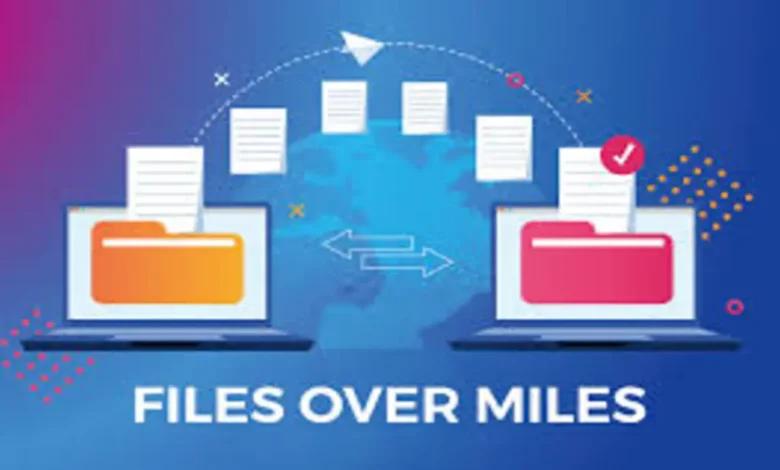Files Over Miles: Bridging Digital Distances in the Modern World
In today’s interconnected world, the ability to share and access files across vast distances has become an essential part of our personal and professional lives. The concept of “files over miles” encapsulates the incredible technological advancements that allow us to effortlessly transmit data across continents, oceans, and time zones. This article delves into the various aspects of sending files over miles, exploring the technologies, challenges, and best practices involved in this crucial aspect of modern communication.
The Evolution of File Sharing Across Distances
From Physical Media to Digital Transmission
The journey of sending files over miles has come a long way from the days of physical media:
- Floppy disks: Once the primary means of transferring files between computers
- CDs and DVDs: Offered larger storage capacities but still required physical transportation
- USB drives: Provided portable storage but still needed to be physically moved
The advent of the internet revolutionized file sharing, enabling instant transmission of data across vast distances.
The Rise of Email Attachments
Email attachments were one of the earliest methods of sending files over miles digitally:
- Allowed users to send small files quickly and easily
- Limited by attachment size restrictions
- Paved the way for more advanced file-sharing methods
Modern Technologies Enabling Files Over Miles
Cloud Storage and Syncing Services
Cloud storage has become a cornerstone of modern file sharing:
- Popular services: Dropbox, Google Drive, iCloud, OneDrive
- Benefits:
- Automatic syncing across devices
- Easy sharing with others
- Large storage capacities
- Collaborative features
File Transfer Protocols (FTP)
FTP remains a reliable method for sending files over miles, especially for larger files:
- Allows for efficient transfer of large files and folders
- Supports resumable transfers in case of interruptions
- Widely used in professional settings
Peer-to-Peer (P2P) File Sharing
P2P networks have revolutionized the way we share files over long distances:
- Decentralized structure allows for efficient distribution of large files
- Popular for sharing media files and open-source software
- Raises concerns about copyright infringement and security
Content Delivery Networks (CDNs)
CDNs play a crucial role in distributing files over miles efficiently:
- Cache content across multiple servers worldwide
- Reduce latency and improve download speeds for users
- Essential for delivering web content, software updates, and streaming media
Challenges in Sending Files Over Miles
Security Concerns
As we send files over miles, ensuring their security becomes paramount:
- Data interception: Files transmitted over unsecured networks can be vulnerable to interception
- Malware: Infected files can spread quickly across large distances
- Privacy issues: Sensitive information may be exposed during transmission
Bandwidth Limitations
The size of files and available bandwidth can impact the efficiency of sending files over miles:
- Large files may take significant time to transfer
- Limited bandwidth in some regions can hinder file sharing capabilities
- ISP data caps may restrict the amount of data that can be transferred
Compatibility Issues
Different systems and software versions can create challenges when sharing files across distances:
- File format incompatibilities
- Version control problems
- Differences in operating systems and applications
Best Practices for Sending Files Over Miles
Compression Techniques
Compressing files before sending them over miles can greatly improve efficiency:
- Reduces file size, making transfers faster
- Saves bandwidth and storage space
- Popular compression formats include ZIP, RAR, and 7Z
Encryption Methods
Protecting sensitive files during transmission is crucial:
- Use end-to-end encryption for secure file transfers
- Implement strong passwords and two-factor authentication
- Consider using Virtual Private Networks (VPNs) for added security
Choosing the Right File Transfer Method
Selecting the appropriate method for sending files over miles depends on various factors:
- File size: Large files may require specialized transfer protocols or cloud storage
- Urgency: Time-sensitive files may benefit from faster transfer methods
- Security requirements: Sensitive data may need additional encryption and secure transfer protocols
Optimizing Transfer Speeds
To improve the efficiency of sending files over miles:
- Use wired connections when possible for faster and more stable transfers
- Schedule large transfers during off-peak hours to avoid network congestion
- Break large files into smaller chunks for easier management and resumable transfers
Industries Revolutionized by Files Over Miles
Media and Entertainment
The ability to send large media files over miles has transformed the entertainment industry:
- Remote collaboration on film and TV productions
- Global distribution of digital content
- Instant sharing of news footage and photographs
Healthcare
File sharing across distances has significant implications for healthcare:
- Telemedicine and remote consultations
- Sharing of medical imaging data between institutions
- Collaborative research across international borders
Education
Distance learning has been greatly enhanced by the ability to share files over miles:
- Online course materials and resources
- Virtual classrooms and remote lectures
- Collaborative projects among students from different locations
Business and Finance
Modern businesses rely heavily on the ability to send files over miles:
- Real-time collaboration on documents and projects
- Secure sharing of financial data and reports
- Global coordination of marketing and sales efforts
The Future of Files Over Miles
5G and Beyond
The rollout of 5G networks and future advancements will further revolutionize file sharing:
- Faster transfer speeds for large files
- Reduced latency for real-time collaboration
- Enhanced mobile file sharing capabilities
Artificial Intelligence and Machine Learning
AI and ML are set to improve the way we handle files over miles:
- Intelligent file compression and optimization
- Predictive caching for frequently accessed files
- Enhanced security measures to protect against evolving threats
Quantum Internet
The development of quantum internet technology could dramatically change how we send files over miles:
- Unhackable file transfers using quantum encryption
- Instantaneous file sharing regardless of distance
- Potential for vast improvements in data storage and retrieval
Legal and Ethical Considerations
Copyright and Intellectual Property
Sending files over miles raises important legal questions:
- Ensuring compliance with copyright laws when sharing media files
- Protecting intellectual property in collaborative environments
- Navigating international copyright regulations
Data Protection Regulations
Various regulations govern the transmission of data across borders:
- General Data Protection Regulation (GDPR) in the European Union
- California Consumer Privacy Act (CCPA) in the United States
- Industry-specific regulations like HIPAA for healthcare data
Digital Rights Management (DRM)
DRM technologies play a role in controlling how files are shared and accessed:
- Protecting copyrighted material from unauthorized distribution
- Implementing usage restrictions on shared files
- Balancing content protection with user accessibility
Conclusion
The future of file sharing promises faster, more secure, and seamless technologies, though it brings challenges in security, privacy, and ethics. By staying informed and adopting best practices, we can maximize the potential of file sharing while minimizing risks. As global collaboration grows, file sharing will continue to bridge not just digital distances, but also bring ideas, knowledge, and creativity closer together, overcoming physical boundaries.







